Cinerama Festival Diary 2012 | Read more at in70mm.com The 70mm Newsletter |
| Written by: David Coles Photos by: Henry Taylor (Leis supplied by: Mark Lyndon). | Date: 24.02.2013 |
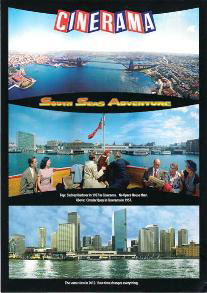  A 7-Day Festival of multi-panel movies
celebrating the 60th Anniversary of Cinerama. Now what self-respecting
widescreen movie enthusiast would want to miss a once-in-a-lifetime
experience like this? A whole week of rarely (and even un-)seen Cinerama
features, documentaries, breakdown films, a French film advertisement, and a
brand new 3-panel short subject – all presented at the worlds most famous
Cinerama venue – the Dome (architect: Pierre Cabrol of Welton Becket &
Associates), near the corner of Sunset & Vine in beautiful downtown
Hollywood, U.S.A. The siren call was heard, and the faithful flocked in from
all over the United States – along with small contingents from Britain,
mainland Europe and South America. Half a dozen enthusiasts also travelled
from Australia to the event. Arriving LAX from Sydney at 6am on Thursday,
September 27, 2012 - I caught the ‘Flyaway’ express bus direct to Union
Station ($7 – but no cash accepted!). A 7-Day Festival of multi-panel movies
celebrating the 60th Anniversary of Cinerama. Now what self-respecting
widescreen movie enthusiast would want to miss a once-in-a-lifetime
experience like this? A whole week of rarely (and even un-)seen Cinerama
features, documentaries, breakdown films, a French film advertisement, and a
brand new 3-panel short subject – all presented at the worlds most famous
Cinerama venue – the Dome (architect: Pierre Cabrol of Welton Becket &
Associates), near the corner of Sunset & Vine in beautiful downtown
Hollywood, U.S.A. The siren call was heard, and the faithful flocked in from
all over the United States – along with small contingents from Britain,
mainland Europe and South America. Half a dozen enthusiasts also travelled
from Australia to the event. Arriving LAX from Sydney at 6am on Thursday,
September 27, 2012 - I caught the ‘Flyaway’ express bus direct to Union
Station ($7 – but no cash accepted!).It had been 19 years since my last trip to Hollywood, and the Los Angeles underground rail network has now spread considerably. For $1.50 I was then whisked to the station at Hollywood & Vine – notable for its movie themed décor. Emerging at street level, I found myself just across the road from the Pantages (Priteca 1930); the first great art deco movie palace (used these days for major live theatre productions). For many years the Pantages hosted the Academy Awards night, and indeed it was there in 1954 that a fellow named Fred Waller was announced as an Oscar winner for the invention of something called ‘Cinerama’. Heading down Hollywood Boulevard towards my hotel, I passed the Hollywood Pacific Building – a combined cinema and office/retail block, which had opened in 1928 as the Warner(s). Once Hollywood’s largest theatre, it was noted for G. Albert Lansburgh’s opulent Moorish interior. It was here that all the 3-strip Cinerama titles enjoyed exclusive Los Angeles runs from 1953 to 1964. Appropriately Lowell Thomas has a sidewalk star right out in front. In 1978 the cinema had its balcony divided in two, creating a triplex, with the downstairs continuing to use its enlarged ‘B’ booth for projection. Finally closing for economic (and seismic) reasons in 1994, the building (like The Dome, designated as a Los Angeles Historic/Cultural Monument) has unfortunately stood sad and largely neglected ever since. When I noticed on the marquee that some religious group was advertising services, I developed a sudden urge to worship at this shrine the following Sunday. Checking into the ‘Motel 6’ – a few doors up a side street from the main ‘strip’ – I was soon out and about again, in search of tinsel. |
More in 70mm reading: Cinerama Color recovery examples in70mm.com's Cinerama page Who is David Coles? John H Mitchell's Twin Presentations Magnified Grandeur Cinerama's Ramine visits Widescreen Weekend 2012 "In the Picture": Filming Completed Anders M Olsson's Images from Cinerama's 60th Anniversary at the Dome Tom March's Images from Cinerama's 60th Anniversary at the Dome Dave Strohmaier and Randy Gitsch - in conversation with Mark Lyndon Ladies and Gentlemen, This is Cinerama! |
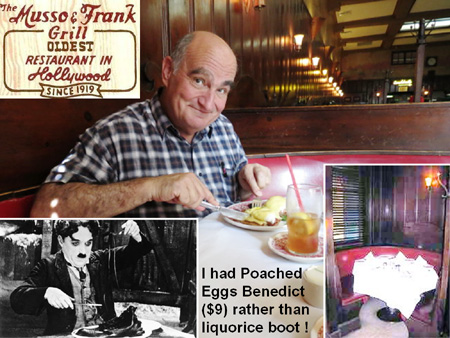 Just across the Boulevard, Larry Edmunds Bookshop - long famous for its
motion picture memorabilia - had not started trading for the day, but
nearby, Musso & Frank Grill - the legendary eatery - was open for breakfast.
Following advice from highly reliable sources (an old Hollywood guide book),
I asked for the ‘Charles Chaplin Table’ - he reportedly ate there regularly.
I soon discovered that it was not hidden away down the back for trysts with
young starlets, as I had imagined, but was in fact ‘Booth One’ – right next
to the front door! Just across the Boulevard, Larry Edmunds Bookshop - long famous for its
motion picture memorabilia - had not started trading for the day, but
nearby, Musso & Frank Grill - the legendary eatery - was open for breakfast.
Following advice from highly reliable sources (an old Hollywood guide book),
I asked for the ‘Charles Chaplin Table’ - he reportedly ate there regularly.
I soon discovered that it was not hidden away down the back for trysts with
young starlets, as I had imagined, but was in fact ‘Booth One’ – right next
to the front door!A bit further along the street, the Highland Center combines a railway station with retail and restaurants, a hotel and other facilities. It includes the Dolby (formerly Kodak) Theatre – home of the Academy Award ceremonies these days. Next door is the famous Grauman’s Chinese Theatre (Meyer & Holler 1927). The forecourt there has become such a tourist mecca, they must surely be on the verge of charging admission – just to see the cement impressions of the stars! I checked out the location of recent addition Peter O’Toole - star of perhaps the most famous and enduring 70mm film of all. El Aurens turned out to be right in front of the main entrance doors (for the moment at least). Just a few feet away was the brass plaque placed in 1958 to commemorate the world premiere engagement there of “Windjammer”, the first and only feature produced in the Cinerama compatible 3-strip CineMiracle process. Across the road, Disney’s ornate El Capitan (G. Albert Lansburgh 1926) was screening a revival of “Finding Nemo” (Now in 3D!). Up the side street alongside Graumans, my next stop was the American Society of Cinematographers recently renovated historic clubhouse. High security fencing has been installed since my last visit, and my initial intercom attempt to gain admission was rejected: “sorry, not open to the public”. Fortunately Marvin Lopez, circulation manager of the ASC magazine, happened to be in the grounds and came over to the gate. (Perhaps my ‘Cinerama’ t-shirt had worked its magic). A guided tour of the premises followed, which included a small museum of cameramen’s tools of trade. A Mitchell ‘Elephant Ears’ VistaVision camera was the key exhibit on this occasion. Unfortunately, due to limited space, most items in their collection, including a Todd-AO ‘bug-eye’ lens, along with Grandeur and other wide format cameras of bygone eras, were all in storage. One cabinet contained some anamorphic widescreen artefacts, including a Chrétien lens used on the first CinemaScope feature “The Robe” (1953). Alongside this was a distinctive gold Vistarama lens which actually cinema-scooped 20th Century-Fox in the anamorphic widescreen race. Commissioned by film producer Carl Dudley from the Simpson Optical Company of Chicago, the lens was used to photograph “Aloha Nui”, an Eastmancolor short subject he made about Hawaii. It opened in Hollywood at the Paramount (now the El Capitan) at 2pm on September 16, 1953 – just hours BEFORE “The Robe” world premiered at the New York Roxy Theatre that evening. |
Internet link: A version of this article first appeared in a recent edition of KINO Cinema Quarterly magazine published by the Australian Cinema and Theatre Society. Subscription enquiries welcome TRIVIA QUIZ: Can you name the first actor to appear in both a 3-strip feature and a 70mm feature? No cheating ! When you give up, you can discover the answer in this article. |
The Carl Dudley name is particularly significant here, in that he produced
the 5th and final Cinerama travel title “South Seas Adventure” (1958). In
fact, for that very evening, I had organised a ‘Carl Dudley Table’ at the Arclight Foyer Café in honour of his achievement. This function - generously
hosted by Tom March, a Canadian Cinerama aficionado – provided the
opportunity for bringing together veterans of the original film, and some of
the people responsible for its return to public viewing after 46 years. Lead
player in this project has been Dave Strohmaier, who has combined digital
restoration work on the vintage titles with the production, earlier this
year, of the first 3-strip Cinerama movie in 50 years: “In The Picture”.
Running 28 minutes (including an Overture – but no Intermission!) this short
subject was scheduled to have its first public presentation the following
morning, launching the Dome Cinerama Festival. Mr Strohmaier wrote, directed
and edited the piece. Co-producer, co-star and narrator was
“How The West
Was Won” veteran Stanley Livingston. As Dave had only just recently been
working on digitalising the second 3-strip feature “Cinerama Holiday" (1955)
and “Windjammer”, it is no surprise to find plot similarities. We follow two
couples as they explore various sites around Los Angeles, and go for a
sailing ship voyage. Written in a deliberately corny 1950s style, his film
is a delightful homage to the great big-screen travel epics which inspired
many of those who voluntarily involved themselves in its production.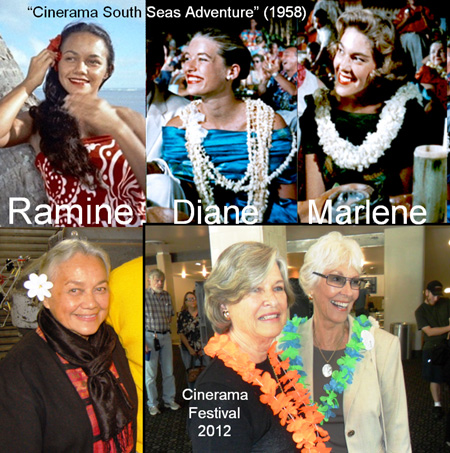 Photos: Dave Strohmaier/Image Trends/Cinerama Inc./David Coles Photos: Dave Strohmaier/Image Trends/Cinerama Inc./David ColesAt noon on Friday the first feature on the program was “Cinerama South Seas Adventure”. This digital version had premiered in April at the Bradford Film Festival Widescreen Weekend. Its South Sea Island star Ramine, who had delighted the UK audience, was again in attendance, along with two other leading ladies from the film – Diane (Beardmore) and Marlene (Lizzio) – who ‘meet’ on board the SS Lurline headed for Honolulu. Also at the Dome, representing the Carl Dudley interest, were two of his daughters – Eleanor and Barbara, along with members of composer Alex North’s family. At 3pm the digital premiere of “Cinerama Holiday” was shown. As with “South Sea” its original camera negatives had been meticulously scanned frame by frame over many months by Image Trends of Texas. The result obtained by their new technology meant that both films were presented in full colour, blemish free and with just a hint of join lines – deliberately left in to satisfy the 3-strip purists. Those attending saw these films in the manner aspired to by Cinerama’s inventor, and subsequent 3-panel research teams. They strove through the fifties to achieve a perfect match of colour between panels, to disguise join lines, and to prevent frame ‘jiggle’. Friday 7pm saw a full house with the first of two showings of the all-star western epic “How The West Was Won” (MGM-Cinerama 1962). Actor Stanley Livingston and stuntman Loren Janes spoke at the commencement. Mr Janes had also attended Bradford earlier this year, when he detailed his multiple death scenes (both as Cowboys AND Indians) along with riding in a rolling wagon, falling from a moving train (in several guises) and - perhaps most challenging of all – doubling for Debbie Reynolds during stampedes and going down rapids. The 3-strip print of “West”, struck 10 years ago – for exclusive use at the Dome – looked magnificent. It was so wonderful to see it again – on a really large (86 x 32 foot) screen. (And I naturally sat in the very front row!) I skipped the 11pm showing of “2001: A Space Odyssey” (1968). It ranks as one my all-time favourite films, and it is perhaps the ultimate single-lens Cinerama presentation – but I needs my beauty sleep. | |
|
At 10am the following morning it was necessary to be on deck for the only
Festival title I had not previously seen. “The Golden Head” (1965) shot in
Technirama and
MCS-70, was a Hungarofilm - Cinerama, Inc. co-production,
described later by Cinerama company owner William R. Forman as: “a film that
should not have been made”. After a short season in London (and an even
shorter one in Manchester) it effectively disappeared from view. It is a
professionally produced ‘family’ crime caper adventure starring George
Sanders and Buddy Hackett as hapless villains trying to outwit some
children. However, like “Holiday In Spain” (aka
“Scent Of Mystery”
Smell-O-Vision 1960) which was due to screen later that evening, it was
reminiscent of pedestrian British ‘B movie’ capers of the 1950s. Normally
one would expect to see this sort of thing in Standard Screen Black & White
– it is quite a culture shock to experience them in giant wide screen colour
and multi-track stereo sound! At 12.45pm on Saturday it was another capacity house – this time for the other MGM-Cinerama co-production of 1962: “The Wonderful World of the Brothers Grimm”. Antipodean enthusiast John H. Mitchell had lovingly preserved this print for decades. (He has spent thousands of dollars over the years keeping his Cinerama prints in air-conditioned luxury, while he himself has sweltered through hot Sydney summers!) It has turned out to be the only known 3-strip version of this film in existence - and it had not been screened in that format in the United States for nearly 50 years. Mr Mitchell donated the print to the Bradford National Media Museum in early 2012, with the proviso that it be made available for Cinerama, Inc. to show at the Dome. In attendance, to introduce the film, was one of its main stars: Russ Tamblyn (who at 77 looks fit enough to still do standing back somersaults). Mr Tamblyn jokingly told the audience that he had brought along two friends on the pretext that they were to be seeing “West Side Story” (1961). His ‘friends’ turned out to be George Chakiris and Rita Moreno (his co-stars in that movie). Although retaining its Technicolor magnificence, the print of “Brothers Grimm” does suffer from ‘age warp’ – so the screening did not proceed without incident. There were several stoppages, and - in the absence of a ‘breakdown film’ to run - Rusty resumed his recollections, regaling the audience with further tales of why he (and many other actors besides) ‘hated’ Cinerama. One of the stops involved a loss of sound. After the screening, Dave Strohmaier (who helps out with 3-strip projection too!) advised me that a re-start in sync would not have been possible on that occasion had he not remembered seeing a photo of me manually edge numbering the new soundtrack that John H. Mitchell had recorded last year (on stock kindly donated by Tom March). It was certainly cheering to know that my hours of labour on that project had been of some value. (Give that man a round of applause!) 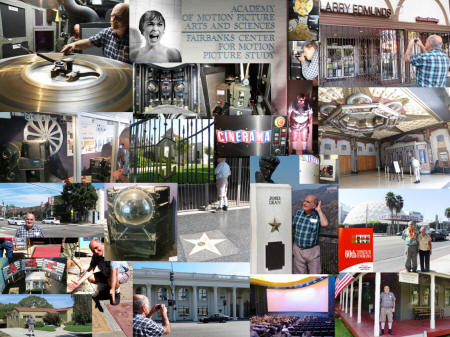 Click
to see enlargement Click
to see enlargementOur Diarist out and about in Hollywood - looking for what Tinsel Town has to offer, and searching for “In The Picture” locations. The next session at the Dome was also made possible due to the generosity of John H. Mitchell – the ‘Mr Cinerama’ of the Southern Hemisphere. Both “Seven Wonders of the World” (1956) and “Search For Paradise” (1957) are now in the process of being digitally scanned. “Seven Wonders” has proved to be a difficult undertaking, as the negatives had been re-assembled over 40 years ago to produce a CinemaScope ‘educational version’ of the title. “Search For Paradise” - yet to be scanned - was shown at 4pm using Mr Mitchell’s original Eastmancolor 3-strip print, which ran through without much trouble (and, sadly, without much colour either). John had also supplied his Act II of “Seven Wonders” – but a digital work-in-progress of that title was cobbled together for the 7pm showing that evening. On Sunday morning I had ‘church’ to attend. Then at 10am, early risers saw the digital version of “Cinerama’s Russian Adventure”. It had been scanned from the 65mm composite negative of the 1966 release, which had been produced by assembling sequences from over half a dozen Russian 3-strip Kinopanorama titles of the 1957-63 period. At 1pm “Windjammer” was also screened digitally. This version of the film, along with “This Is Cinerama”, is now available on BluRay/DVD from flickeralley.com. Due to 3-strip negative deterioration, alternative sources were used as restoration elements for these two titles. “This Is Cinerama” came from a 65mm composite negative created for a 1972 theatrical re-release, while “Windjammer” was extracted from a CinemaScope print of the film held by the Swedish Film Institute. 4.30pm Sunday saw another ‘full house’ in the 856 seat auditorium of the Dome for a 70mm Ultra Panavision screening of “It’s A Mad, Mad, Mad, Mad World”. It was at the opening of this very theatre that Stanley Kramer’s comedy had world premiered on November 7, 1963. (50th Anniversary celebrations are planned for 2013). It was with mixed feelings that I watched this film again – its successful launch had sealed the fate of Cinerama’s 3-strip technique. The ‘single-lens process’ would now exploit the Cinerama name to present a series of epic, and not so epic, 70mm titles for the remainder of the 1960s. 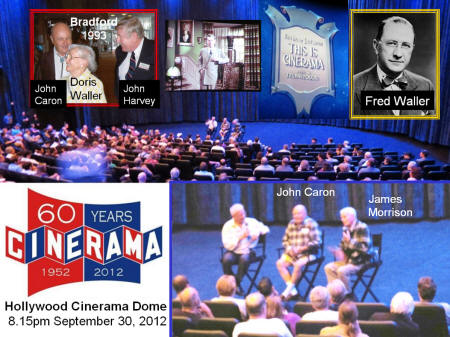 Click
on the image to see a large version Click
on the image to see a large versionAt 8.15pm Sunday, September 30, 2012 came the centrepiece attraction of the whole week of festivities: “This Is Cinerama” presented using a pristine 10 year old 3-strip print. Each screening during the week was introduced by John Sittig – Director of Projection at the Arclight Dome Cinema Complex. Approaching retirement, John has been a keen supporter of activities involving 3-strip restoration and presentation during his 33 years with the company. It was his particular pleasure to preside over the 60th Anniversary screening of the film which launched the widescreen/stereosound era of motion pictures. All the senior participants in the original historic production are now sadly gone. Fred Waller and Mike Todd were early departures, while Lowell Thomas, Merian C. Cooper, Hazard Reeves and company have also been pushing up the daisies for many summers. 86 year old Doris Waller, widow of the inventor, was delighted to attend the relaunching of true Cinerama at Bradford in 1993. On this occasion in Los Angeles it was to be her 86 year old son John Caron who was able to represent the Waller family. As a young man, Mr Caron had watched the emergence of his stepfathers multi-panel experiments – from 11 x 16mm to the 5x 35mm Gunnery trainer of WWII, and on to the 3-panel large frame 35mm final format. He was later to spend the 1950s as a Cinerama, Inc. employee involved with theatre installations around the country. John was at the Broadway Theatre on opening night September 30, 1952 in ‘Able’ Booth, when the film take-up failed. As the picture was still on the screen, John overruled the theatre projectionists’ inclination to hit the ‘Stop All’ button. The show continued without interruption while film cascaded onto the projection room floor. Joining John Caron on stage was fellow veteran James Morrison, who provides supplementary commentary on the Flicker Alley DVD. Jim had been an enthusiastic young filmmaker looking for guidance (in editing some 16mm film he had shot) from a Pawling, N.Y. neighbour in late 1951. That neighbour - Lowell Thomas, arranged for Jim to join the tennis court studio team at Oyster Bay where he gained experience helping film editor Bill Henry piece together the watershed production. (A link to the present is the fact that Jim’s nephew Lincoln Morrison worked as sound recordist on “In The Picture”.) Having been connected to history by two men who were intimately involved, and actually there on the opening night exactly 60 years before, a full house at the Dome then thrilled again to the epoch-making words of Mr Thomas: “Ladies and Gentlemen - This is Cinerama …” For many in attendance this was the final highlight in three days of highs – however the festival still had four days to go, involving repeat screenings of most titles screened over the weekend. 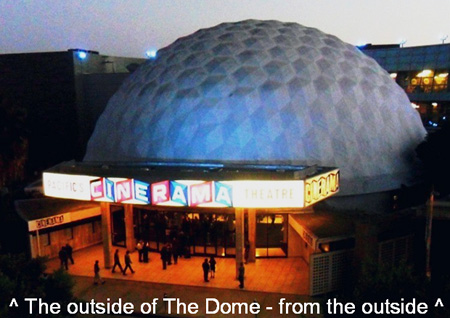 I returned for all of the 3-strips and several of the digital screenings,
concluding the week on Thursday October 4 with the viewing of a 3-strip
triple bill; “Search For Paradise”, “This Is Cinerama” and finally “How The
West Was Won”. I’ve lost track now of how many times I’ve seen these titles
(when originally released/in a Sydney back garden/at Bradford) – BUT HEY
they don’t make-’em or show-’em like this no more, so every opportunity must
be grasped with gusto! At an end-of-festival BBQ hosted by Dave Strohmaier
(that man of many talents), I had the opportunity to ask Stanley Livingston
a question that has been on the mind of many “How The West Was Won” devotees
for 50 years. Mr Livingston revealed that he had been queried on this
particular topic countless times, and could but offer the suggestion that
the matter had been handled as it was for technical/logistic reasons. The
issue? In a film so full of spectacular on-location photography, why were
the closing close-ups of him and the Rawlings family - riding a buckboard in
Monument Valley - shot in the studio with back projection? (One of only a
few nagging flaws in a magnificent epic). It is a sad irony that these last
on-screen words spoken in the last 3-strip feature ever made were shot in
65mm Ultra Panavision. Thus the seeds of doom were sown. After the Thursday
night screening of that very film, it was back to the hotel for some sleep –
as there was a 6am start required Friday for the commencement of a 3-week
odyssey I had planned across the South-Western United States. Leaving behind
the bright lights and excitement of Hollywood, my proposed heavy schedule
left little time to reflect on the amazing week of pleasures just concluded.
So many people had made the event possible. It was the culmination of 40
years of effort in ‘keeping the 3-strip flame alive’ by people like Gunther
Jung, John Harvey,
Willem Bouwmeester, John H. Mitchell,
Keith Swadkins,
Britain’s National Media Museum, Larry Smith,
Randy Gitsch, and the
countless enthusiasts around the world who cared. But the main accolade for
this occasion must go again to Dave Strohmaier for the energy and enthusiasm
(not to mention time) he has invested in his interest, since being
‘wonderfied’ by “Seven Wonders” at the St Louis Ambassador 55 years ago. I returned for all of the 3-strips and several of the digital screenings,
concluding the week on Thursday October 4 with the viewing of a 3-strip
triple bill; “Search For Paradise”, “This Is Cinerama” and finally “How The
West Was Won”. I’ve lost track now of how many times I’ve seen these titles
(when originally released/in a Sydney back garden/at Bradford) – BUT HEY
they don’t make-’em or show-’em like this no more, so every opportunity must
be grasped with gusto! At an end-of-festival BBQ hosted by Dave Strohmaier
(that man of many talents), I had the opportunity to ask Stanley Livingston
a question that has been on the mind of many “How The West Was Won” devotees
for 50 years. Mr Livingston revealed that he had been queried on this
particular topic countless times, and could but offer the suggestion that
the matter had been handled as it was for technical/logistic reasons. The
issue? In a film so full of spectacular on-location photography, why were
the closing close-ups of him and the Rawlings family - riding a buckboard in
Monument Valley - shot in the studio with back projection? (One of only a
few nagging flaws in a magnificent epic). It is a sad irony that these last
on-screen words spoken in the last 3-strip feature ever made were shot in
65mm Ultra Panavision. Thus the seeds of doom were sown. After the Thursday
night screening of that very film, it was back to the hotel for some sleep –
as there was a 6am start required Friday for the commencement of a 3-week
odyssey I had planned across the South-Western United States. Leaving behind
the bright lights and excitement of Hollywood, my proposed heavy schedule
left little time to reflect on the amazing week of pleasures just concluded.
So many people had made the event possible. It was the culmination of 40
years of effort in ‘keeping the 3-strip flame alive’ by people like Gunther
Jung, John Harvey,
Willem Bouwmeester, John H. Mitchell,
Keith Swadkins,
Britain’s National Media Museum, Larry Smith,
Randy Gitsch, and the
countless enthusiasts around the world who cared. But the main accolade for
this occasion must go again to Dave Strohmaier for the energy and enthusiasm
(not to mention time) he has invested in his interest, since being
‘wonderfied’ by “Seven Wonders” at the St Louis Ambassador 55 years ago.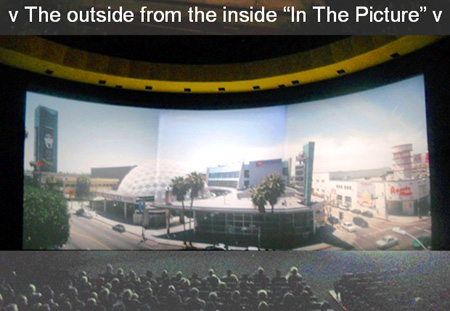 To John Sittig and Pacific/Arclight, operators of the Dome and owners of the
Cinerama Inc. assets, our boundless gratitude for getting behind the
restoration venture and presenting a Festival with flair and attention to
detail. Their Café sported a special Cinerama Menu inspired by the film
titles, their Gift Shop stocked a variety of clothing, caps, key chains,
glasses, mugs and other items featuring the familiar concertina logo. Apart
from a specially printed Festival programme ($5) there were reprints of
original souvenir books and postcards of all the titles (50cents). Those
with a little more to spend could fork out $99.95 for one of the original
lenses provided by Cinerama, Inc., at no charge, to cinemas who ran Cinerama
‘single-lens’ titles. (Revenue came from a royalty on the takings of any
films shown using the lens and Cinerama name). There were quite a few sold
during the week! Showcases at the Dome contained various Cinerama related
paraphernalia, including the legendary camera #1, an underwater
camera-housing built for “Brothers Grimm” - but never used, a three winged
slate from “South Seas Adventure”, a three lensed viewfinder, scripts,
books, record sleeves, and posters of all kind from the glory days. What a
wonderful week. To John Sittig and Pacific/Arclight, operators of the Dome and owners of the
Cinerama Inc. assets, our boundless gratitude for getting behind the
restoration venture and presenting a Festival with flair and attention to
detail. Their Café sported a special Cinerama Menu inspired by the film
titles, their Gift Shop stocked a variety of clothing, caps, key chains,
glasses, mugs and other items featuring the familiar concertina logo. Apart
from a specially printed Festival programme ($5) there were reprints of
original souvenir books and postcards of all the titles (50cents). Those
with a little more to spend could fork out $99.95 for one of the original
lenses provided by Cinerama, Inc., at no charge, to cinemas who ran Cinerama
‘single-lens’ titles. (Revenue came from a royalty on the takings of any
films shown using the lens and Cinerama name). There were quite a few sold
during the week! Showcases at the Dome contained various Cinerama related
paraphernalia, including the legendary camera #1, an underwater
camera-housing built for “Brothers Grimm” - but never used, a three winged
slate from “South Seas Adventure”, a three lensed viewfinder, scripts,
books, record sleeves, and posters of all kind from the glory days. What a
wonderful week. | |
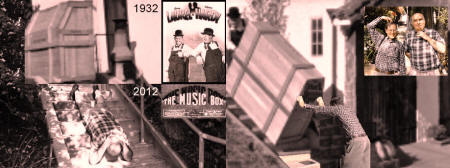 Two
present day clowns recreate ‘music box steps’ set-ups from the famous Oscar
winning Laurel & Hardy short subject. Two
present day clowns recreate ‘music box steps’ set-ups from the famous Oscar
winning Laurel & Hardy short subject.Click on it, and a larger version will appear. The Festival screening schedule allowed some free mornings, providing the opportunity to visit Hollywood area points of interest. With fellow devotee Henry Taylor (from New Mexico) who had a car, visits were made to places like the Hollywood Heritage Museum – housed in the original 1913 Lasky-DeMille barn studio (relocated). Two Laurel & Hardy classic locations were also tracked down: “Big Business” (1929) and “The Music Box” (1932). “In The Picture” location hunting, we also paid a visit to the bust of James Dean at Griffith Park Observatory. A day was spent at the Margaret Herrick Library in Beverly Hills, which houses much rare film related print material. A “Psycho” exhibit there featured documentation on display related to the part Janet Leigh played in the film. The original script named her character Mary Crane (as in the novel), but astute script researchers in film pre-production discovered someone of that name in the Phoenix telephone directory. The film was set there, so to avoid offence Mary became Marion. (Ah, trivia – lovely trivia!) After a photo opportunity at the old MGM studio entrance (now Sony Pictures Entertainment), it was off to nearby Hillside Memorial Park. Upon entering this Jewish Cemetery one is confronted by a spectacular waterfall spilling down from a hilltop Greek temple-like structure. | |
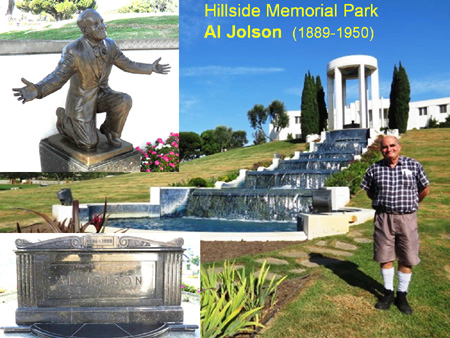 It turned out to be a tribute to just one man. Just as Lowell Thomas is
associated with the launching of Cinerama and the widescreen era in 1952, Al
Jolson is justifiably credited with introducing sound to motion pictures 25
years before - with “The Jazz Singer” (1927). (Note to pedants: Yes, I KNOW
it wasn’t actually the first sound film ever made!) Returning to our hotel,
we noticed some excitement around the corner on Hollywood Boulevard. A star
was being unveiled on the sidewalk. A man prominent in the proceedings
looked just like the man who made the highest grossing film of all time (in
the latest form of Cineramic realism - Digital Imax 3-D yet!). So it was no
surprise to learn that the honouree was Gale Anne Hurd, who had acted as
producer on some of James Cameron’s earlier films. Thus ended the 60th
Anniversary Cinerama Festival Week - so many giant screen thrills, and so
much tri-panelled excitement with 7-track multi-directional sound, all
packed into a mere 7 days – just how much can a koala bear !?! It turned out to be a tribute to just one man. Just as Lowell Thomas is
associated with the launching of Cinerama and the widescreen era in 1952, Al
Jolson is justifiably credited with introducing sound to motion pictures 25
years before - with “The Jazz Singer” (1927). (Note to pedants: Yes, I KNOW
it wasn’t actually the first sound film ever made!) Returning to our hotel,
we noticed some excitement around the corner on Hollywood Boulevard. A star
was being unveiled on the sidewalk. A man prominent in the proceedings
looked just like the man who made the highest grossing film of all time (in
the latest form of Cineramic realism - Digital Imax 3-D yet!). So it was no
surprise to learn that the honouree was Gale Anne Hurd, who had acted as
producer on some of James Cameron’s earlier films. Thus ended the 60th
Anniversary Cinerama Festival Week - so many giant screen thrills, and so
much tri-panelled excitement with 7-track multi-directional sound, all
packed into a mere 7 days – just how much can a koala bear !?!THE END | |
Encore In Pictures ... | |
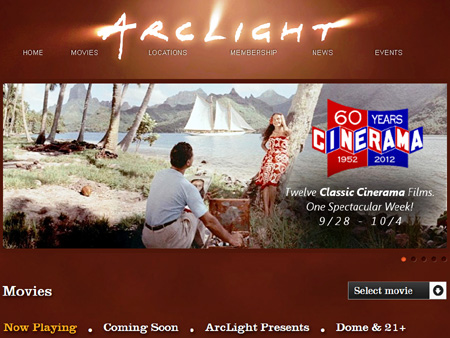 Booking online allows you to choose your own Dome seat – which is great. I
bought a ticket (by credit card) to nearly every session, but had to perform
each transaction separately – which was a bit time consuming. Booking online allows you to choose your own Dome seat – which is great. I
bought a ticket (by credit card) to nearly every session, but had to perform
each transaction separately – which was a bit time consuming. | |
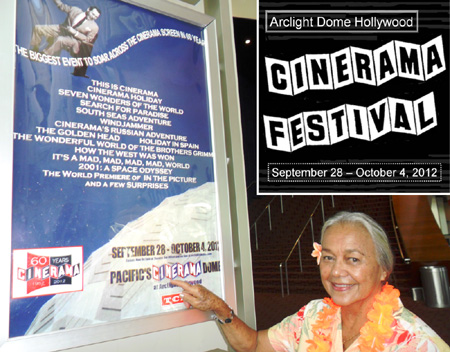 ‘The Biggest Event to Soar Across the Cinerama Screen in 60 Years’ attracted
attendees from all around the world, including this young lady from Bora
Bora. ‘The Biggest Event to Soar Across the Cinerama Screen in 60 Years’ attracted
attendees from all around the world, including this young lady from Bora
Bora. | |
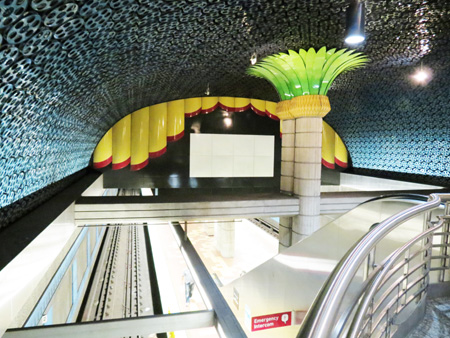 Surely a delight for those who love both movies AND railways - the Hollywood
& Vine subway station features a ceiling composed of thousands of 2000 foot
reels, with a ‘proscenium’ of ceramic curtains and screen. Two old carbon
arc projectors are also displayed in the entrance area. Surely a delight for those who love both movies AND railways - the Hollywood
& Vine subway station features a ceiling composed of thousands of 2000 foot
reels, with a ‘proscenium’ of ceramic curtains and screen. Two old carbon
arc projectors are also displayed in the entrance area. | |
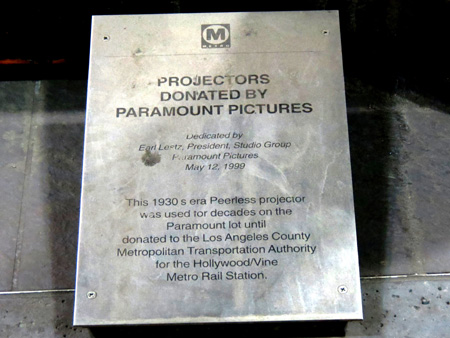 Instead of sending two clapped-out old studio film projectors to the rubbish
tip, Paramount donated them to the LA Transit System and had a plaque
dedicated to them for their trouble. Instead of sending two clapped-out old studio film projectors to the rubbish
tip, Paramount donated them to the LA Transit System and had a plaque
dedicated to them for their trouble. | |
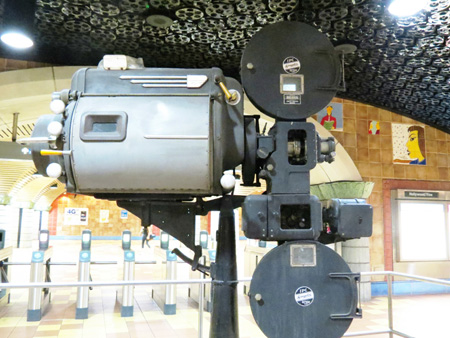 The two projectors on display in the Hollywood & Vine concourse are
identified simply as ‘1930s era Peerless’ – which might be enough
information for passing commuters – however, to be a bit more precise they
are 1930s era Super Simplex projectors with RCA PS 24 (MI-1040) sound heads
and 1950s era Peerless Magnarc carbon arc lamps on 5 point pedestals. The two projectors on display in the Hollywood & Vine concourse are
identified simply as ‘1930s era Peerless’ – which might be enough
information for passing commuters – however, to be a bit more precise they
are 1930s era Super Simplex projectors with RCA PS 24 (MI-1040) sound heads
and 1950s era Peerless Magnarc carbon arc lamps on 5 point pedestals. | |
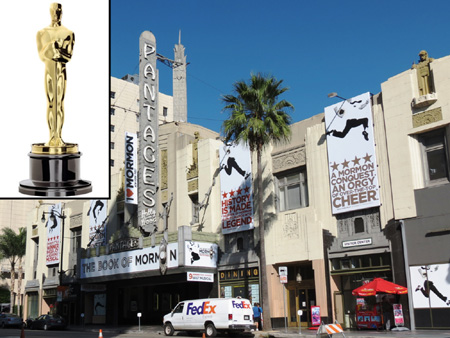 At ‘Oscar Night’ on March 25, 1954 here at the Pantages all the big winners
(for 1953) were in Standard Screen Black & White. Due to illness, Fred
Waller was not able to attend this ceremony to receive his Academy Award for
inventing Cinerama. He died (aged 68) just a few weeks later, on May 18. At ‘Oscar Night’ on March 25, 1954 here at the Pantages all the big winners
(for 1953) were in Standard Screen Black & White. Due to illness, Fred
Waller was not able to attend this ceremony to receive his Academy Award for
inventing Cinerama. He died (aged 68) just a few weeks later, on May 18. | |
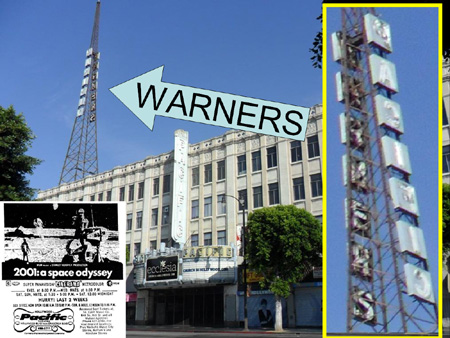 After Pacific Theatres took over Stanley Warner Theatres in 1968 they
decided to re-badge this Hollywood landmark. As ‘Warners’ had the same
number of letters as the new name ‘Pacific’, the change of signage was
achieved quite simply by covering the old – and the previous name is still
visible today. After Pacific Theatres took over Stanley Warner Theatres in 1968 they
decided to re-badge this Hollywood landmark. As ‘Warners’ had the same
number of letters as the new name ‘Pacific’, the change of signage was
achieved quite simply by covering the old – and the previous name is still
visible today. | |
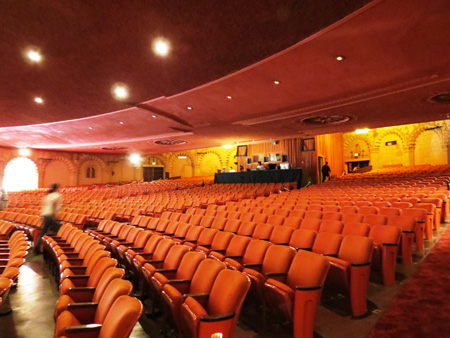 The Hollywood Warners ‘Able’ and ‘Charlie’ projection booths are long gone,
but ‘Baker’ – enlarged in 1964 for ‘single-strip’, remains in place. The
Balcony area was divided off in 1978 to create a triplex. The front gates of
the cinema have been locked for nearly 20 years, but access is possible now
– not never, but always - on Sunday. The Hollywood Warners ‘Able’ and ‘Charlie’ projection booths are long gone,
but ‘Baker’ – enlarged in 1964 for ‘single-strip’, remains in place. The
Balcony area was divided off in 1978 to create a triplex. The front gates of
the cinema have been locked for nearly 20 years, but access is possible now
– not never, but always - on Sunday. | |
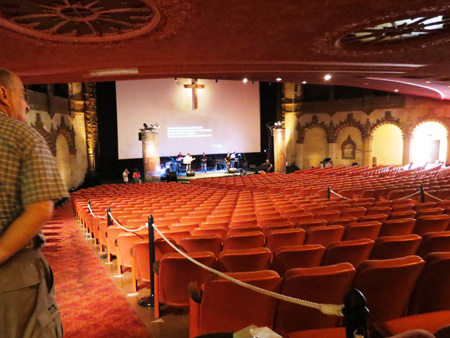 A simple cross now marks the location of the Hollywood Warners 76 x 28 foot
louvred screen. Opening April 29, 1953 this was the third Cinerama venue,
running 3-strip until “How The West Was Won” ended November 29, 1964. The
theatre name was changed to Hollywood Pacific in 1969 just weeks before the
season of its last Cinerama presentation (“2001”) ended. A simple cross now marks the location of the Hollywood Warners 76 x 28 foot
louvred screen. Opening April 29, 1953 this was the third Cinerama venue,
running 3-strip until “How The West Was Won” ended November 29, 1964. The
theatre name was changed to Hollywood Pacific in 1969 just weeks before the
season of its last Cinerama presentation (“2001”) ended. | |
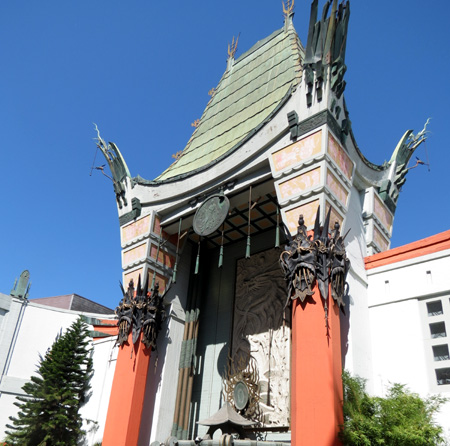 | |
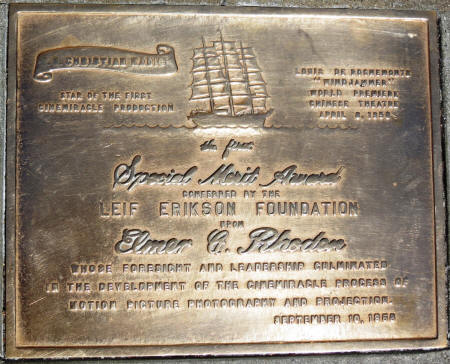 In 1958 National Theatres arranged an award for their head man - and a (now
well worn) brass plaque in their Grauman’s forecourt. This was to
congratulation themselves for losing a fortune in developing the copycat
CineMiracle format to rival 3-strip Cinerama. (A process which, to be
honest, had been virtually obsolete technology from the day it opened 6
years earlier). In 1958 National Theatres arranged an award for their head man - and a (now
well worn) brass plaque in their Grauman’s forecourt. This was to
congratulation themselves for losing a fortune in developing the copycat
CineMiracle format to rival 3-strip Cinerama. (A process which, to be
honest, had been virtually obsolete technology from the day it opened 6
years earlier).Click on the image to see an enlargement | |
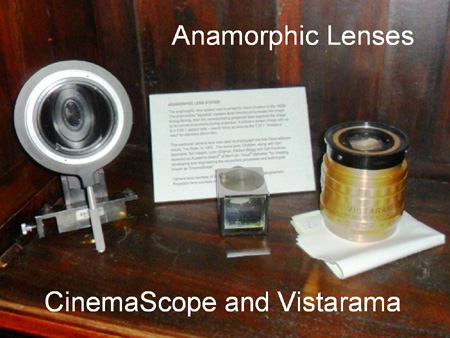 The American Society of Cinematographers clubhouse (not open to the public)
has on display various items related to the history of movie photography,
including showcases featuring vintage cameras and lenses. The American Society of Cinematographers clubhouse (not open to the public)
has on display various items related to the history of movie photography,
including showcases featuring vintage cameras and lenses. | |
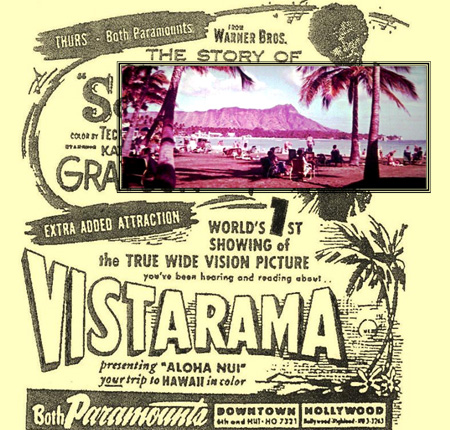 Los Angeles newspaper advertisement for Carl Dudley’s 11 minute anamorphic
colour short subject “Aloha Nui”. Los Angeles newspaper advertisement for Carl Dudley’s 11 minute anamorphic
colour short subject “Aloha Nui”.INSET shows an image from the film – which had an aspect ratio identical to CinemaScope. | |
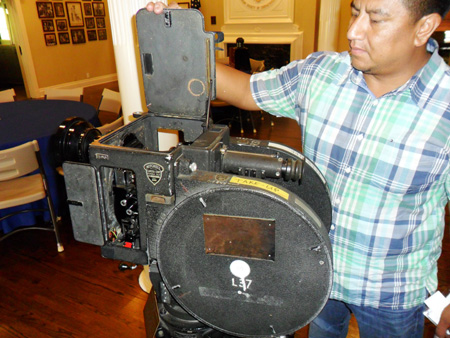 The ASC’s Marvin Lopez opens their display Mitchell VistaVision camera #3
for inspection. As the horizontal process used twice the frame area of
normal 35mm film, the magazines were designed to hold 2000 feet instead of
the normal 1000 feet. The ASC’s Marvin Lopez opens their display Mitchell VistaVision camera #3
for inspection. As the horizontal process used twice the frame area of
normal 35mm film, the magazines were designed to hold 2000 feet instead of
the normal 1000 feet. | |
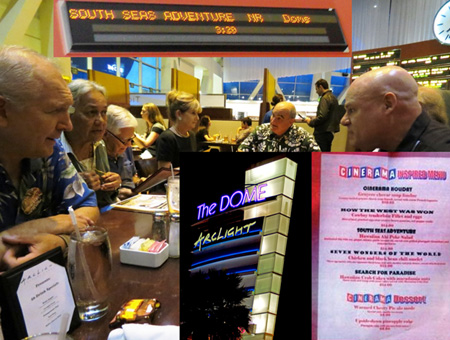 Checking out what’s on the Arclight Café special ‘Cinerama Menu’ at the Carl
Dudley Table Thursday September 27. Checking out what’s on the Arclight Café special ‘Cinerama Menu’ at the Carl
Dudley Table Thursday September 27. | |
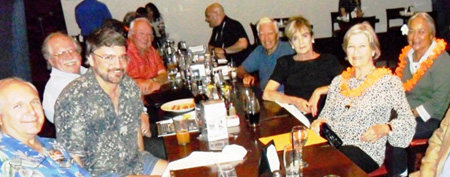 Tom March, Dan Sherlock, Dave Strohmaier, Brian Allsopp, Randy Gitsch,
Bruce Seaman, Eleanor Dudley Pillsbury, Diane Paton (Beardmore) and Ramine
Seaman. Tom March, Dan Sherlock, Dave Strohmaier, Brian Allsopp, Randy Gitsch,
Bruce Seaman, Eleanor Dudley Pillsbury, Diane Paton (Beardmore) and Ramine
Seaman. | |
 On their way to the first day of screenings, this bunch of old pals: Bruce
Seaman, James Holloway, Henry Taylor, David Coles and Ramine Seaman (who had
all met a few months before at Bradford), stopped for breakfast at the
‘Caffe Etc’ on the corner of Cahuenga & Selma. I don’t remember us
mentioning to the management that we were off to a 60th Birthday
celebration, but despite there being only 20 or so tables in the almost
empty restaurant, we were order #60. Certainly a positive omen! On their way to the first day of screenings, this bunch of old pals: Bruce
Seaman, James Holloway, Henry Taylor, David Coles and Ramine Seaman (who had
all met a few months before at Bradford), stopped for breakfast at the
‘Caffe Etc’ on the corner of Cahuenga & Selma. I don’t remember us
mentioning to the management that we were off to a 60th Birthday
celebration, but despite there being only 20 or so tables in the almost
empty restaurant, we were order #60. Certainly a positive omen! | |
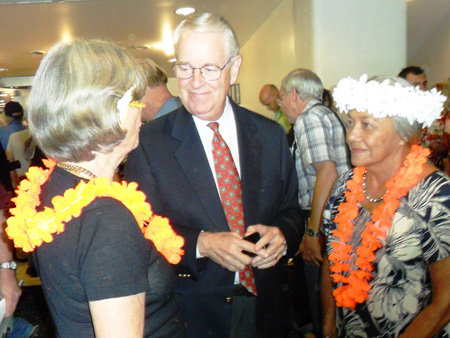 Dan Sullivan - President and CEO of Image Trends - was delighted to actually
meet in person some of the Cinerama stars (like Diane and Ramine from” South
Seas Adventure”) at the Festival. He and his team had been looking at their
images on film for months as they carefully scanned every frame of the three
panelled scenes for the digital reconstruction work. Dan Sullivan - President and CEO of Image Trends - was delighted to actually
meet in person some of the Cinerama stars (like Diane and Ramine from” South
Seas Adventure”) at the Festival. He and his team had been looking at their
images on film for months as they carefully scanned every frame of the three
panelled scenes for the digital reconstruction work. | |
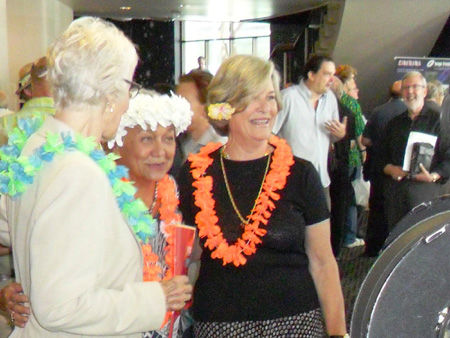 At the Intermission of “Cinerama South Seas Adventure” Film Reviewer Leonard
Maltin tries to remember whether the flower over ‘Kay Johnson’s’ right ear
means she’s spoken for, or available. (One time actress Diane Paton entered
into the spirit of the occasion). At the Intermission of “Cinerama South Seas Adventure” Film Reviewer Leonard
Maltin tries to remember whether the flower over ‘Kay Johnson’s’ right ear
means she’s spoken for, or available. (One time actress Diane Paton entered
into the spirit of the occasion). | |
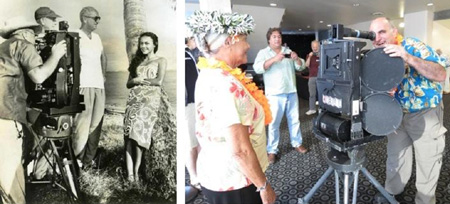 LEFT: Ramine being ‘filmed’ with camera #6 in a 1957 publicity photo for
“Cinerama South Seas Adventure” with cameraman ‘Jack’ Warren, director Basil
Wrangell and producer Carl Dudley. LEFT: Ramine being ‘filmed’ with camera #6 in a 1957 publicity photo for
“Cinerama South Seas Adventure” with cameraman ‘Jack’ Warren, director Basil
Wrangell and producer Carl Dudley. RIGHT: Ramine in the Dome foyer 2012 with camera #3 which was restored for shooting a new Cinerama short subject – Dave Strohmaier’s “IN THE PICTURE” a few months earlier. | |
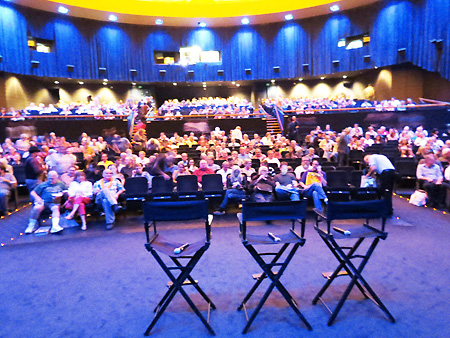 Instead of three separate booths, the Dome was built with one extremely long
box, although the A and C equipment at each end were not installed for
nearly 40 years. Normal titles these days are projected in 4K digital, while
35/70 capability is retained with a Kinoton machine which can be moved aside
for the 3-strip B projector. Instead of three separate booths, the Dome was built with one extremely long
box, although the A and C equipment at each end were not installed for
nearly 40 years. Normal titles these days are projected in 4K digital, while
35/70 capability is retained with a Kinoton machine which can be moved aside
for the 3-strip B projector. | |
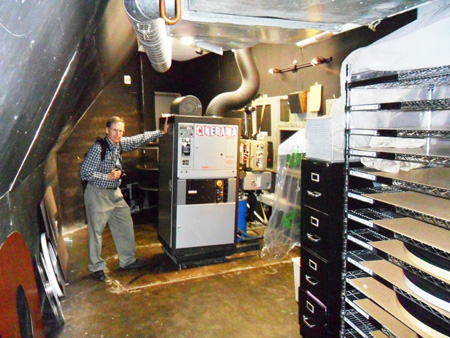 Henry Taylor stands next to ‘Charlie’ projector. Original Century 6-perf.
Cinerama heads are used at the Dome, but carbon arcs are replaced by xenons,
and the film feeds off platters. Note the sloping wall of the Dome at left,
and the racks at right which are used for the prints of “This Is Cinerama”
and “How The West Was Won” - which are permanently held at the theatre. Henry Taylor stands next to ‘Charlie’ projector. Original Century 6-perf.
Cinerama heads are used at the Dome, but carbon arcs are replaced by xenons,
and the film feeds off platters. Note the sloping wall of the Dome at left,
and the racks at right which are used for the prints of “This Is Cinerama”
and “How The West Was Won” - which are permanently held at the theatre. | |
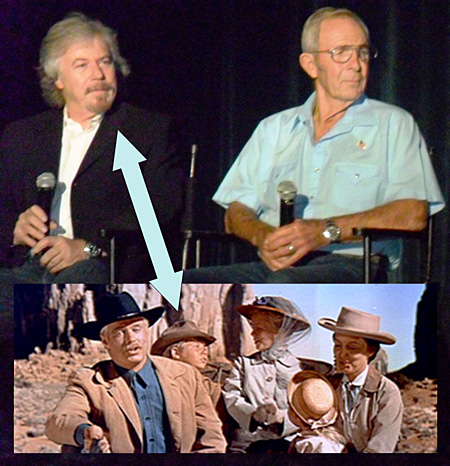 Actor Stanley Livingston and stuntman Loren Janes introduce “How The West
Was Won” at the Dome. Actor Stanley Livingston and stuntman Loren Janes introduce “How The West
Was Won” at the Dome. INSET: Monument Valley closing close-up from the film, shot on an MGM sound stage in 65mm Ultra Panavision using back projection. | |
 Russ Tamblyn as a woodsman ‘in disguise’, with Yvette Mimieux as ‘The
Dancing Princess’ in “The Wonderful World of the Brothers Grimm”
(MGM-Cinerama 1962) which had its first US 3-strip screenings for 49 years
at the Dome Cinerama Festival. INSET Russ Tamblyn introducing the film –
photo by Tom March. Russ Tamblyn as a woodsman ‘in disguise’, with Yvette Mimieux as ‘The
Dancing Princess’ in “The Wonderful World of the Brothers Grimm”
(MGM-Cinerama 1962) which had its first US 3-strip screenings for 49 years
at the Dome Cinerama Festival. INSET Russ Tamblyn introducing the film –
photo by Tom March. | |
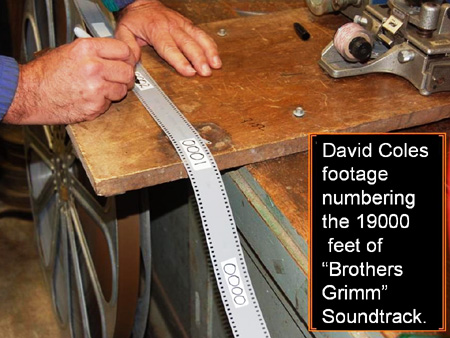 ‘Joke’ photo sent by John H. Mitchell to Dave Strohmaier. Actually, I only
registered every 100 feet of the new soundtrack - but this still took a
darned long time, as the frame mark has to be correct to the sprocket hole. ‘Joke’ photo sent by John H. Mitchell to Dave Strohmaier. Actually, I only
registered every 100 feet of the new soundtrack - but this still took a
darned long time, as the frame mark has to be correct to the sprocket hole. | |
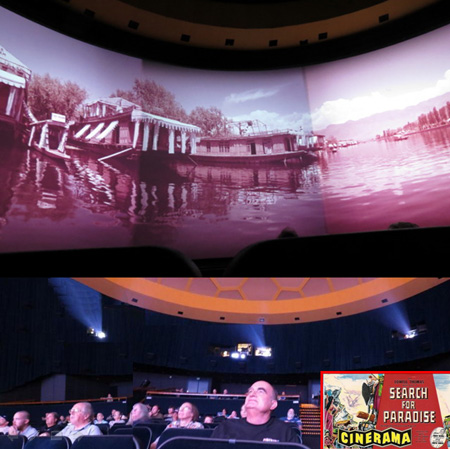 “Search For Paradise” (1957) was screened twice using an original
Eastmancolor print kindly loaned for the occasion by John H. Mitchell of
Sydney. As with “Brothers Grimm”, this is the only known complete 3-strip
print. Composer Dimitri Tiomkin was represented by family members at the
showing. “Search For Paradise” (1957) was screened twice using an original
Eastmancolor print kindly loaned for the occasion by John H. Mitchell of
Sydney. As with “Brothers Grimm”, this is the only known complete 3-strip
print. Composer Dimitri Tiomkin was represented by family members at the
showing. | |
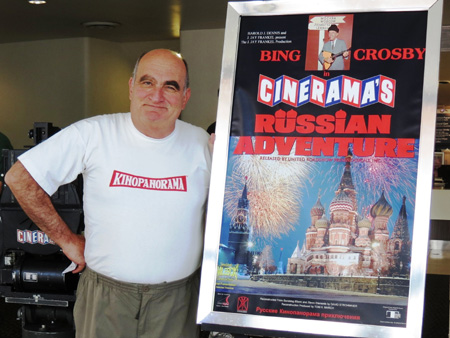 My link with the Soviet 3-panel system is that I ran the Sydney premiere
season of “Cinerama’s Russian Adventure” (in 70mm) at my Comrade Dave’s
Encore Moviehouse in the late 1970s. Then 15 years later I obtained this
t-shirt for serving as assistant wombat wrangler on John Lasher’s
Kinopanorama short subject “Bounty” (1995). My link with the Soviet 3-panel system is that I ran the Sydney premiere
season of “Cinerama’s Russian Adventure” (in 70mm) at my Comrade Dave’s
Encore Moviehouse in the late 1970s. Then 15 years later I obtained this
t-shirt for serving as assistant wombat wrangler on John Lasher’s
Kinopanorama short subject “Bounty” (1995). | |
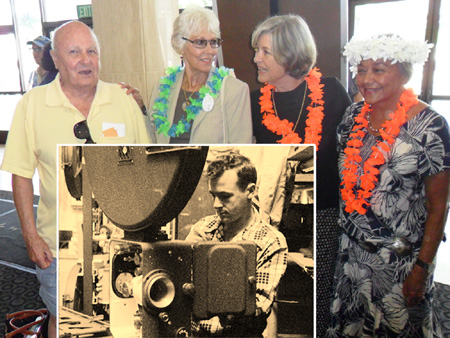 Fred Waller’s stepson John Caron with the “South Seas Adventure” girls –
Marlene, Diane and Ramine – September 2012. INSET: John at Oyster Bay
September 1952 preparing a projector for installation at the Broadway
Theatre. (Photo courtesy John Caron) Fred Waller’s stepson John Caron with the “South Seas Adventure” girls –
Marlene, Diane and Ramine – September 2012. INSET: John at Oyster Bay
September 1952 preparing a projector for installation at the Broadway
Theatre. (Photo courtesy John Caron) | |
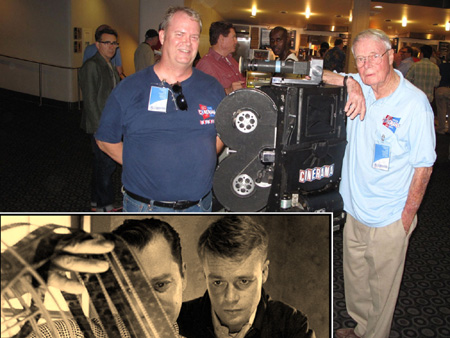 Cinerama “In The Picture” crew member Lincoln Morrison with his uncle James
Morrison September 2012. Cinerama “In The Picture” crew member Lincoln Morrison with his uncle James
Morrison September 2012. INSET: Jim assisting “This Is Cinerama” film editor Bill Henry at Oyster Bay September 1952. (Photo courtesy George Morrison) | |
 Arclight’s John Sittig introduces Ramine to the audience at a screening of
“Cinerama South Seas Adventure”. Arclight’s John Sittig introduces Ramine to the audience at a screening of
“Cinerama South Seas Adventure”. | |
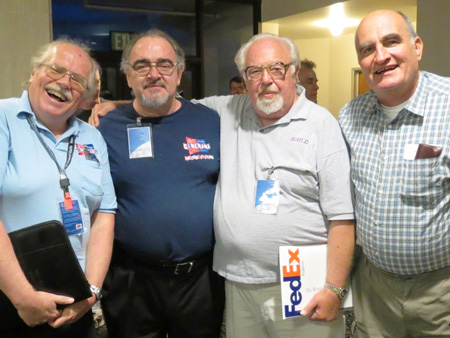 Four ‘well-fed’ (we won’t say fat) wide-film festival fiends: Dan Sherlock,
Martin Hart, Larry Karstens and David Coles. Four ‘well-fed’ (we won’t say fat) wide-film festival fiends: Dan Sherlock,
Martin Hart, Larry Karstens and David Coles. | |
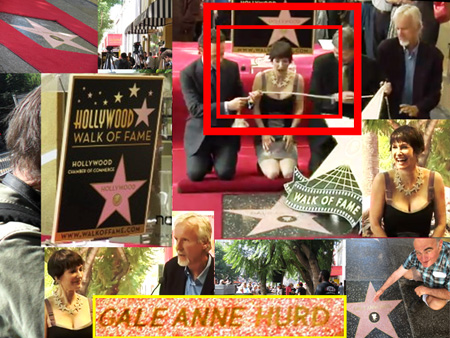 Gale Anne Hurd looks genuinely surprised when she turns out to be the person
in a star on the sidewalk in front of her – perhaps she was relieved they
got her name right. Gale Anne Hurd looks genuinely surprised when she turns out to be the person
in a star on the sidewalk in front of her – perhaps she was relieved they
got her name right. | |
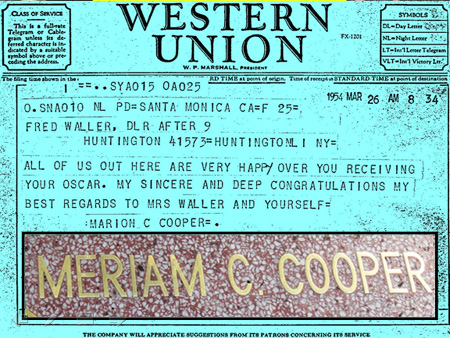 “This Is Cinerama” co-producer MERIAN C. COOPER was not so lucky – he
has been waiting decades for them to correct his misspelt Christian name
(even Western Union can’t get it right). “This Is Cinerama” co-producer MERIAN C. COOPER was not so lucky – he
has been waiting decades for them to correct his misspelt Christian name
(even Western Union can’t get it right). | |
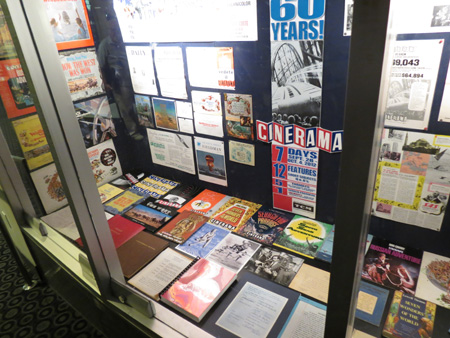 Posters, dodgers, stills, souvenir books, scripts, record album covers –
memorabilia of all sorts in a Dome foyer display case. Posters, dodgers, stills, souvenir books, scripts, record album covers –
memorabilia of all sorts in a Dome foyer display case. | |
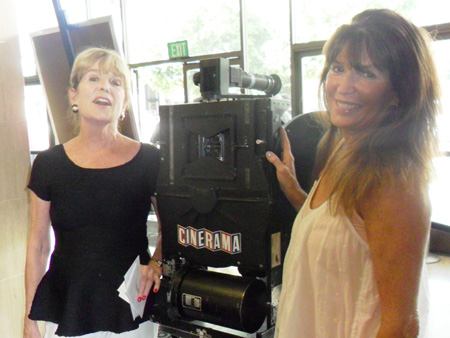 “Cinerama South Seas Adventure” was produced for Stanley-Warner by Carl
Dudley (1910 -1973). Two of his daughters Eleanor Dudley Pillsbury and
Barbara Ward Dudley attended the Dome Cinerama Festival representing the
family. “Cinerama South Seas Adventure” was produced for Stanley-Warner by Carl
Dudley (1910 -1973). Two of his daughters Eleanor Dudley Pillsbury and
Barbara Ward Dudley attended the Dome Cinerama Festival representing the
family. | |
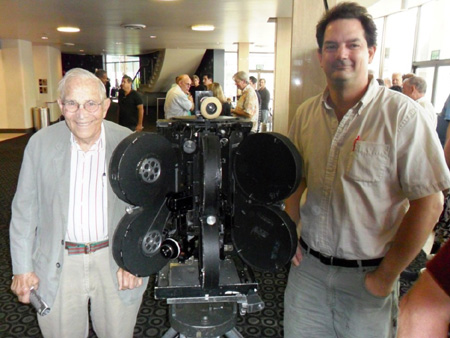 Norman Karlin was a film editor starting at Oyster Bay in 1953 - staying
with the company until 1964. Also with Cinerama during this period was
camera engineer Eric Rondum. Peter Rondum (right) was pleased to meet some
of his fathers old work colleagues at The Dome Festival. Norman Karlin was a film editor starting at Oyster Bay in 1953 - staying
with the company until 1964. Also with Cinerama during this period was
camera engineer Eric Rondum. Peter Rondum (right) was pleased to meet some
of his fathers old work colleagues at The Dome Festival. | |
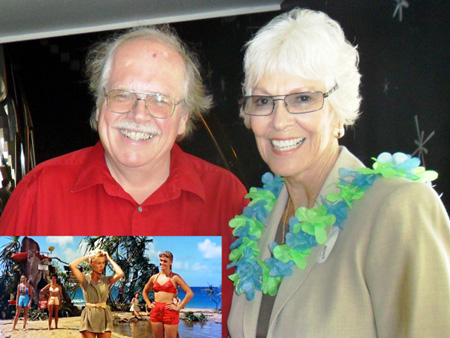 Some years ago this Diarist posted a question on ‘rec.arts.movies.tech’:
Name the first actor to appear in both a 3-strip feature and a 70mm feature.
Daniel J. Sherlock was the only entrant to correctly identify the person.
Dan was delighted to meet her at The Dome. Marlene Lizzio (now Marlene
Aragon) performed in the 1958 releases “Cinerama South Seas Adventure” AND
“South Pacific” (in which she helped Mitzi ‘wash that man right out of her
hair’). Some years ago this Diarist posted a question on ‘rec.arts.movies.tech’:
Name the first actor to appear in both a 3-strip feature and a 70mm feature.
Daniel J. Sherlock was the only entrant to correctly identify the person.
Dan was delighted to meet her at The Dome. Marlene Lizzio (now Marlene
Aragon) performed in the 1958 releases “Cinerama South Seas Adventure” AND
“South Pacific” (in which she helped Mitzi ‘wash that man right out of her
hair’). | |
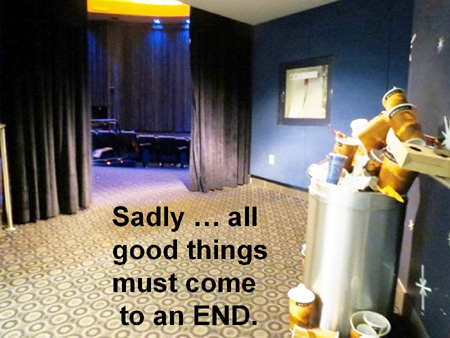 | |
| Go: back - top - back issues - news index Updated 22-01-25 |
